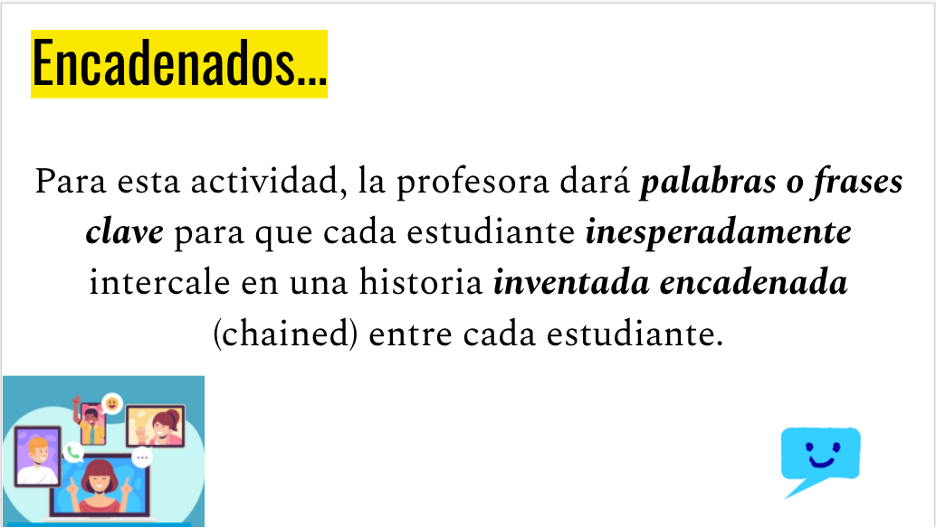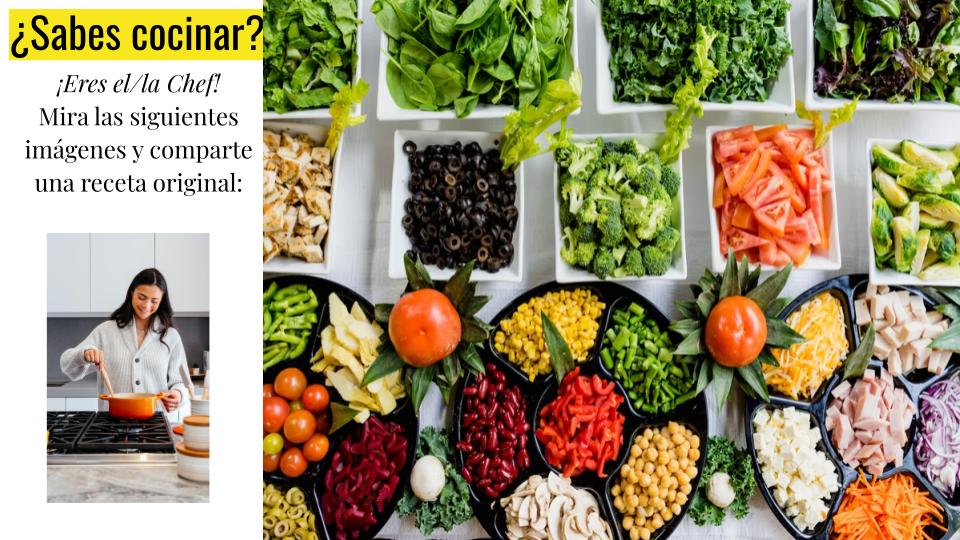Spanish Club Online: An Extracurricular Experience for Building a Community of Thriving Language Learners
By María I. Ortiz, Associate Professor, University of Cincinnati – Blue Ash College

Introduction: Spanish Club Pre- and During COVID-19
As a language educator, have you ever heard this: “I want to learn a language, and I want to speak with confidence, but where do I do this outside of class?” This is a common statement shared by language learners across all levels. Many students hesitate to speak because they might feel overly conscious of their speaking or they overthink what they want to say; then stage fright takes over and reduces their speaking potential, for what then turns into them staying on the sidelines of potentially great and successful language learning experiences. This can be a dealbreaker in building confidence and furthering interest and progress for students learning a language. In the case of university students, extracurricular activities like study abroad, language clubs, guest speaker presentations, movie clubs, cultural projects, and other service-learning opportunities where the second language or target language is the focus of all interactions are key spaces for students to experiment and experience language on their own, at the same time as they work on expanding their proficiency, as well as acquiring new language skills.
Prior to COVID-19, there were many opportunities to invite students to participate and delve into speaking the language. In the case of the University of Cincinnati Blue Ash College (UCBA) the UCBA Spanish Conversation Club had a successful run during the fall semester of 2019 and a solid start for the spring semester of 2020: a total of 7 meetings for a total of 7 contact hours, all face-to-face with 56 participants overall.
Then, the COVID-19 pandemic hit, and transformed all aspects of life, and for teaching and learning, extracurricular interactions were severely affected – study abroad was cancelled, service-learning opportunities were limited (and some nonexistent), and other language learning interactions seemed to quickly fade, as everyone was struggling to navigate this unique moment in our lifetime.
From an academic perspective, students, educators, staff, and other learning communities felt disengaged with and disconnected from education, but with a summer to prepare for fall courses, the possibility of an online version of the UCBA Spanish Conversation Club became stronger, especially as former students asked about its return for the fall of 2020. In a space where language is about connecting with people, the limitations brought by the pandemic compelled me as the Spanish Club faculty advisor to envision and design a club experience that could work for all. I had in mind similar activities to what I was doing in class, but now focused on the club’s purpose and the fact that students were longing for connection and community. The club could be one of many spaces where students engage and connect in a meaningful way, at the same time as they work on their Spanish language skills and proficiency.
Development of the Club and Structure
The first step was to move the club online, which we did using Zoom for the meeting sessions. This link was shared on the University of Cincinnati’s CampusLINK student outreach platform, as well as in the Campus weekly email announcements. The fact that it was being held online opened participation to students in other campuses of the university. This turned out to be a success, as students could join the club for practicing español regardless of their college or campus. In the past, the club was led by students, meaning that they started the sessions in the Language Lab, welcomed the students, directed and led activities, in addition to selecting times, dates, and topics for future sessions. Due to the pandemic, students explicitly shared that they were afraid to commit to a full leadership role in the club because of the uncertainty of not being able to lead the session for various reasons (poor internet connection, being sick, or simply not being able to connect). This is why during this time, several people led sessions based on the topic selected, and why there has been no formal government structure like in other campus groups or associations.
As the faculty advisor for the club, I managed the 50-minute sessions, while students came and joined for as long as they wished to. At the same time, I recorded attendance and shared the attendance list with the department’s faculty in case they decided to provide any additional participation points for being engaged during the meeting. We had monthly and bi-monthly meetings during the year, increasing hours of language contact outside of the classroom for:
- a total of 10 meetings via Zoom (10 contact hours online outside of class);
- a total of 46 participants from different course levels (basic to intermediate, 2 heritage speakers).
Students selected all topics for the club, which included some cultural topics as well as grammar and vocabulary (slang phrases, food vocabulary and gastronomical practices, Halloween and Day of the Dead, Christmas vocabulary, dealing with the pandemic, subjunctive mood, numbers, past tense forms, among others).
The fact that students continued to select the topics for the sessions made them feel welcomed and empowered within the club. This resulted in interactions and friendships that were so meaningful that students requested for the first time to have the Spanish club continue over the summer session. This shows a strong case for how technology has expanded learning opportunities for students, as it provided a space for community and connection for language practice and learning that was able to continue even over the summer when students normally would have dispersed to various locations.
Tech Tools Integrated and Sample Activities
Another challenge that I was faced with was the task of incorporating aspects of learning that involved the students’ senses, as well as a sense of collaboration and spontaneity. For example, during the face-to-face meetings, students were using their hands while recreating a Dead of the Day Altar, using Play-Doh and other craft making materials for making Halloween decorations while explaining the parts of the body, playing the game “Operation”, and having spontaneous conversations while eating and participating during the club session. As part of my language courses, I had already integrated various technologies that worked within the face-to-face classroom that helped increase student engagement like Mentimeter, Kahoot, Quizizz, and I was aware they could be powerful engagement tools for participation and interaction in an online learning environment, so I began incorporating them into the club meetings.
The first tool that I implemented was Google Slides, which I started using more extensively after completing the Google for Education Train the Trainer program. I quickly noticed that students enjoyed logging on all at the same time to work together, while adding a bit of a fun, competitive edge as they worked on completing tasks while pacing each other. For the Spanish club, I simplified some of the activities, focusing more on speaking and listening. The interactive component of Google Slides turned into a place to record notes and responses that students could download after the session for further reference.
Since strengthening speaking and listening skills are some of the main objectives of the club, I integrated Wheel Decide and Wheel of Names – great tools for inputting questions and generating authentic dialogue about a topic or vocabulary. Questions came up on one wheel and on another were students’ names to promote participation by a variety of speakers. If a student hesitated to share out loud, they interacted via the Zoom chat, which was a great way to continue conversations and interactions, allowing a diverse conversational space.

Other activities involved playing games live. For example, versions of the game “Taboo”, “Secret Word”, or “Don’t Say the Word”, could be played while one student looked away from the screen, an image from the daily vocabulary list was shared via the Zoom chat using a link, and the student had to guess what it was. This generated spontaneous conversations, laughter, and use of vocabulary words. At the same time, we did improvised conversations with an activity that I called “encadenados con palabras” (meaning linked with words) for story weaving, where one student started a story based on a vocabulary card shown, and from there I kept showing different cards or sticky notes with unique words or concepts to add and improvise with. Finally, when the students felt that they had run out of ideas, they tagged another club member to continue the conversation. Students felt challenged to produce authentic conversations on the spot using their knowledge and noted this as one of their favorite interactions.

There were many other activities; we had one review session exclusively for subjuntivo, where students were shown pictures of people in different challenging real-life situations, and they had to provide advice using advanced grammar skills. Students that did not have this grammar background used Deber + verbo (should + action) and Tener que + verb (to have to), still participating in the activity but adjusting it to their level (while previewing and getting familiarized with more advanced grammar). This allowed students once again to use critical thinking skills in the target language in meaningful and memorable ways, since it was applied to real-life situations.

An essential point of these activities involved a cultural context that was key for the background sections of the session, including a thematic session about Halloween and Día de los Muertos, where both cultural practices were discussed, contrasted, and compared, providing an enriching cultural experience.
In the activity ¿Qué recuerdas? (What do you remember?), students were guided to work on visual learning and memory by looking at an image for a minute, then writing what they remember in Spanish, and then sharing with the group. It was fascinating to see that working together all seven participants were able to recreate and identify almost 70% of the details from the picture.
|
|
|
Still, some of the sensory components were missing from our meetings, until we did a session on food. This day, students had a picture of different foods that I provided, and for the next 5-7 minutes they had to share their favorite recipe based on the image. Because I shared the Google slide via the Zoom chat, students took turns marking on the picture the different ingredients they were “preparing”. This allowed students to track each other and, at the same time, ask about different words used for certain ingredients like: judías verdes or habichuelas tiernas to refer to green beans, or setas, hongos, or champiñones for mushrooms.

The different cultural approaches for food allowed for a deeper conversation on the meaning of food and the influences of other languages and cultures through what we eat, and how this impacts how we talk about food and culture. Then the session became even more alive, as one of the students was at her house, and she decided to share the steps to the fresas con chocolate recipe that she was making for her friends that night. She had everything prepared in her kitchen and inverted her phone camera to have a cooking show for the Spanish club. It was one of the best and most fulfilling surprise sessions of the club, as students started asking specific questions about the strawberries: ¿Dónde compras las fresas: en el mercado o en el supermercado? (Where do you buy the strawberries?) or ¿Qué chocolate prefieres: dulce o chocolate con leche? (What kind of chocolate do you prefer: sweetened or milk chocolate?) ¿Por cuánto tiempo van las fresas en el refri? (For how long do you keep the strawberries in the fridge?). This experience was also unique for the student that was cooking, because she had never thought about cooking en español (in Spanish), and it made her feel more appreciative of the food and the cooking process. This was one of many activities the students not only found memorable, but allowed for that needed connection with others, and became a unique experience where they connected through one of the basic needs: food.
Looking into the Future of the Club
As I think of what could come next for the UCBA Spanish Conversation Club, many options come to mind, all depending on how the pandemic develops. I think having the opportunity and option to allow students to join online remotely, as in a hyflex option, could allow for more interaction and participation even beyond the pandemic. In the same line, offering one session in person and alternating with online in a following meeting could be another possibility, all based on health advisories. Another element could be finding other Spanish clubs in universities at the state level, or even nationally and internationally, to connect with students for more practice in a diverse setting, at no additional cost. Finally, the UCBA Spanish Conversation Club could integrate a future service-learning component, if the club could be allowed to connect with a neighboring school in the community and practice Spanish either online once a month, and then meet in person if health advisories allow for it. The possibilities are endless thanks to the club moving online, and I am hopeful that the next faculty advisor will consider different options and modalities in which this extracurricular experience can be shared with the language learning community and supported through various technologies.
Conclusion
As I draw this reflection about my experience as a faculty advisor of the UCBA Spanish Conversation Club to a close, I can proudly share that this has been a unique and unforgettable learning experience for everyone involved. From planning in-person meetings, to being able to transition to an online modality and delivery, to keeping the club present and active (including during the summertime) in the middle of a pandemic has been a labor of love and an uplifting and unforgettable challenge and gift. Being able to provide a space for increasing language proficiency and confidence is an honor and a responsibility I have taken to heart to make it a unique and relevant community for the students. And during a pandemic, the fact that technology allowed the club to establish a consistent welcoming space for a thriving community of language learners shows that the impact of connection transcends the means in which it is delivered. Finally, we can affirm the positive aspects of integrating technology for practical and meaningful purposes in language learning pedagogy, as it keeps the door open for more interactions while it continues to allow a language community to grow that is tightly connected through this global system of hyperconnectivity that is the internet. What’s next in language learning and extracurricular practices? Human connections, creativity, technology, and an honest desire to keep the language practice and presence alive!




Hello Amanda and Beth, thank you for your comments and interest on this article.
Beth: I been using Wheel Decide since 2017 in all my classes, and when I taught in China, students loved it and had a lot of fun with the idea of going along with the wheel’s selections. You can also use it for competitions (having sentences on the wheel and then cresting teams to answer the questions); you can have 3 wheels: two wheels with names and a 3 one with questions – fill in the blanks. This way everyone plays along and get them exciting about participating and talking. Many possibilities!
Amanda: I cannot tell you how much student enjoyed the club! The summer session was really good because students had community and connection, especially for students that graduated and still wanted to come in for practice. We are so lucky that we can still offer it for everyone that wants to come in and practice for 15 minutes or the whole hour.
Feel free to contact me if you would like to collaborate or talk more!
Thanks for sharing so many ideas! We moved our conversation online last year, but are now trying it in person again. So many of your ideas could be used in either format. I am particularly interest in trying out the Wheel Decide app!
Thank you for sharing! What wonderful ideas! We moved ASL club online during the pandemic and I was amazed every week at the participation. Students are craving social interaction more than ever and these clubs can really provide that to them.